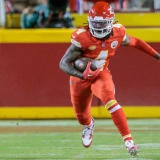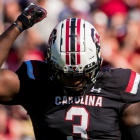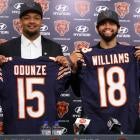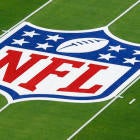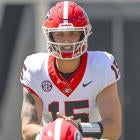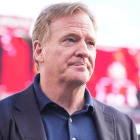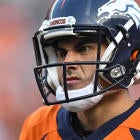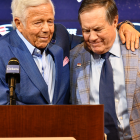In the lead-up tp the annual NFL draft, you hear a whole lot about team needs. Nobody wants to enter the season with an obvious roster weakness, so filling holes is often a big part of the consideration when teams come on the clock for their selections.
But we're not here to talk about who filled needs. You can find that analysis all over this site. Instead, we're going to take a look at the teams who used at least one of their draft picks to build on top of a strength. Because it's always nice to have a strength that is so overpowering that even when the opponent tries to take it away, they're bound to fail.
Take the 49ers, for example. While most expected them to use the No. 13 overall pick on one of the draft's top wide receivers, John Lynch instead traded down one spot, picked up some additional draft capital, and used the selection (acquired from the Colts in the DeForest Buckner trade) to add another quality player at the team's greatest position of strength: defensive line. Already armed with Nick Bosa, Dee Ford, Arik Armstead, Solomon Thomas, Ronald Blair, and more up front, the Niners added a dynamic interior rusher in Javon Kinlaw, who ranked second in this interior D-Line class in Adjusted Overall Win Rate. (A combination of Pro Football Focus' Pass Rush Win Rate and Run Stops, weighted so that pass rush is more important than run defense.) Kinlaw should help replace what the Niners lost by dealing Buckner, and at a significantly lower cost.
A few picks later, the Cowboys essentially did the inverse of what the 49ers had just done. Most expected the No. 17 overall pick to be spent on a defender, but instead Dallas just took the best player available and added CeeDee Lamb to a wide receiver corps that already included Amari Cooper and Michael Gallup. Dak Prescott threw for 4,902 yards and 30 touchdowns last season, and his front office just replaced his No. 3 wideout with perhaps the best receiver in the draft (he led all draftable receivers in Yards Per Route Run), an after-catch marvel who can play both outside and in the slot, allowing the team to mix and match with him and Cooper to create mismatches all over while Gallup stretches the field on the perimeter.
Also in the first round, the Jaguars drafted K'Lavon Chaisson, adding strength to a position where they already had a player in Josh Allen who would have been the Defensive Rookie of the Year in a normal season where someone like Nick Bosa did not exist. Adding Chaisson also gives Jacksonville the freedom to be patient with Yannick Ngakoue trade talks, because they have the edge covered now with two players still on their rookie deals. They'll welcome Ngakoue back if he wants to be there, but they can also still pursue trades while he allows the franchise tag window to expire.
It was surely surprising to some to see the Dolphins draft cornerback Noah Igbinoghene after they made Xavien Howard and Byron Jones the highest-paid cornerback duo in the league, but it's clear that Brian Flores is attempting to build a defense that strongly resembles the one his former boss has built in New England. The Dolphins clearly value the ability to play press man coverage across the board on the outside, allowing Flores to mix and match with players like Kyle Van Noy, Elandon Roberts, Shaq Lawson, and Emmanuel Ogbah up front. Igbinoghene is smaller and not quite as long as Jones and Howard, but he's an above-average athlete and should translate well to the slot. Think of him as Miami's version of Jason McCourty, who complemented Stephon Gilmore and J.C. Jackson on the perimeter the past couple seasons.
Speaking of the Patriots, they had just about the Patriots-est Day 2 possible. Their first pick was used on Division II safety Kyle Dugger, who tested in the 99th percentile for athleticism among safeties. Sure, they already have Devin McCourty, Patrick Chung, and Adrian Phillips, but why not add a player who can develop into the long-term replacement for one of those guys a year or two down the line? Similarly, they stacked up yet again on versatile hybrid linebacker/edge rusher types by nabbing both Josh Uche and Anfernee Jennings. They started re-stocking here last year by drafting Chase Winovich, and now they added players who ranked second and fifth and Adjusted Overall Win Rate on the edge, and also have the flexibility to play in coverage.
The Saints did something similar by adding Zack Baun to a defensive front that already included Cameron Jordan and Marcus Davenport to rush the edge, plus Demario Davis, Kiko Alonso, and Alex Anzalone at linebacker. Baun fits comfortably in either role, having landed a player who ranked highly in Adjusted Overall Win Rate and acquitted himself nicely when asked to flow sideline to sideline in the run game and/or drop back into coverage. That kind of versatile chess piece can help take the Saints defense a step further in the right direction. (The Steelers did something similar by adding Alex Highsmith to an edge group already featuring T.J. Watt and Bud Dupree.)
Buffalo has spent a ton of money and draft capital the past two seasons upgrading its offense, bringing in John Brown, Cole Beasley, Stefon Diggs, Mitch More, Quinton Spain, Cody Ford, and more in order to put Josh Allen in as good a position to succeed as possible. So it made sense for them to turn to the defensive side of the ball with their first pick, which they used on E.J. Epenesa, who will help replace the hole left by Lawson's departure in free agency and Lorenzo Alexander's retirement. Did they already have Jerry Hughes, Mario Addison, and Trent Murphy? Sure, but why not add another, similarly-styled player to the group so that when those older players move on, you don't need to replace quite as many of them with immediate contributors?
The Ravens approached things similarly in the second and third rounds. The strength of their offense in 2019 was the most versatile and dynamic run game in perhaps the history of the league, and Mark Ingram played a big role in making that ground game so successful. But he's also 30 years old and likely to move on after the 2020 season, when the Ravens can save $5 million against the cap by cutting ties, so they added J.K. Dobbins a year before they really needed a new back. Similarly, Justin Madubuike may not step into the lineup ahead of any of Calais Campbell, Brandon Williams, or Derek Wolfe in Year 1, but he'll surely be able to pick up the slack whenever any of them leaves over the next couple years. This was a team with very few weaknesses to begin with, and it spend Day 2 making two of its greatest strengths even stronger.
The division rival Browns didn't come into the draft with quite as few weaknesses as the Ravens, but certainly one of their greatest strengths had to be considered their defensive line. They already had Myles Garrett, Olivier Vernon, Adrian Clayborn, and Chad Thomas on the outside, plus Larry Ogunjobi, Sheldon Richardson, and Andrew Billings on the interior. Then, they added Jordan Elliott to that group inside, a player who ranked first among interior D-Linemen in Adjusted Overall Win Rate, posting numbers more similar to an edge rusher than a defensive tackle. That, again, is how you stack on top of a strength.










